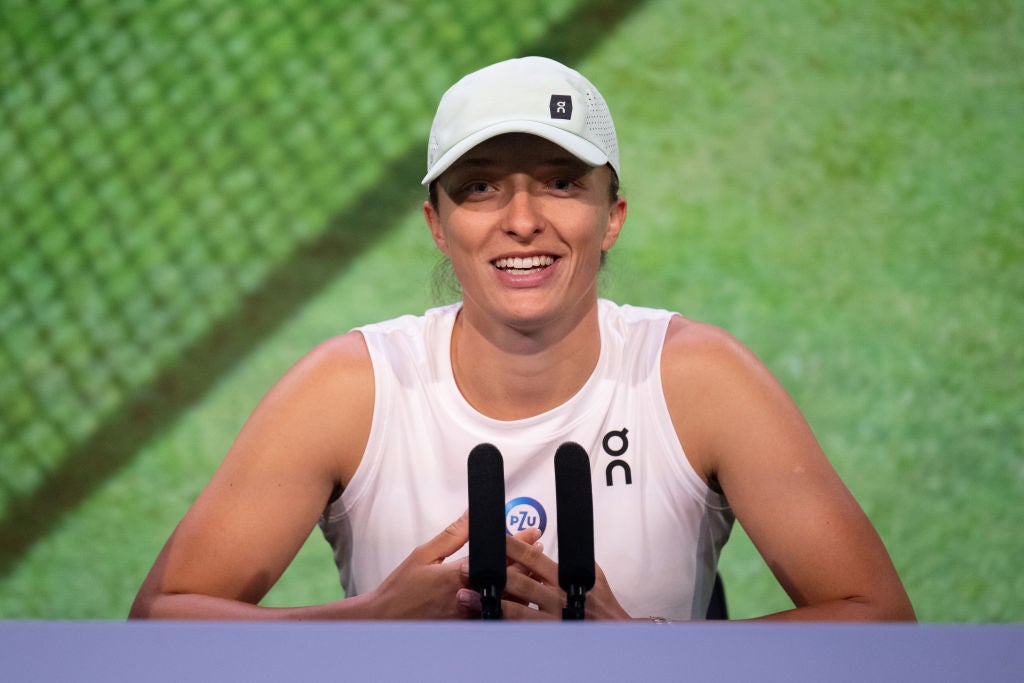Iga Swiatek has dominated tennis but not Wimbledon - is that about to change?
The World No 1 will look to find her feet on grass in SW19 as she looks to take advantage of a favourable draw

Your support helps us to tell the story
From reproductive rights to climate change to Big Tech, The Independent is on the ground when the story is developing. Whether it's investigating the financials of Elon Musk's pro-Trump PAC or producing our latest documentary, 'The A Word', which shines a light on the American women fighting for reproductive rights, we know how important it is to parse out the facts from the messaging.
At such a critical moment in US history, we need reporters on the ground. Your donation allows us to keep sending journalists to speak to both sides of the story.
The Independent is trusted by Americans across the entire political spectrum. And unlike many other quality news outlets, we choose not to lock Americans out of our reporting and analysis with paywalls. We believe quality journalism should be available to everyone, paid for by those who can afford it.
Your support makes all the difference.The transition from clay to grass in the three-week period between the French Open and Wimbledon is notoriously difficult. Figuring out how to peak at both Roland Garros and SW19 is a skill that takes years to master, and the short interlude only heightens the pressure that players face when they are forced to adjust to the new bounce and configure their movement on the starkly different surface.
Last year, Iga Swiatek arrived at Wimbledon on the back of a 35-match win streak and as the dominant force at the top of women’s tennis, but admitted she allowed the unique challenge grass presents to throw her off her game. A thigh injury that limited her preparation time even further did not help the 22-year-old’s confidence or mentality to attack the competition. Swiatek looked uncomfortable on the grass from her opening match and in the end it was not great surprise that a wily opponent such as Alize Cornet claimed the upset in only the third round.
But the mood, it seems, is different now. For one, Swiatek has been able to play matches on grass ahead of Wimbledon - with the Pole looking rather more settled at last week’s warm-up tournament at Bad Homburg. Swiatek is more adjusted to her position of World No 1 and has since added two more grand slams to her resume - a third French Open in four years, as well as the US Open last September.
While her expectations remain relatively low, Swiatek is also able to take a freer approach into Wimbledon without a record winning streak to extend. “Last year I felt a lot of pressure here because I was number one,” Swiatek said. “I don’t know. I feel like this time, this is the first year where I could just focus on practising, actually learning a lot. So hopefully I’m going to be able to use that on my matches.”
This, too, before you consider the draw. Tennis has a new big three with Swiatek, Aryna Sabalenka and Elena Rybakina - the winners of the last five grand slam titles. Before Wimbledon, and assuming all players would be at their full fitness, most observers would have placed Rybakina as the favourite to defend her title with Sabalenka, a former semi-finalist at the All England Club, not far behind. But both Rybakina and Sabalenka have fallen into the same half of the draw, along with several dangerous threats who have found form coming into Wimbledon.
The two-time Wimbledon champion Petra Kvitova is among them, on Rybakina’s side, after her title in Berlin. Jelena Ostapenko, a recent winner in Birmingham, is also in the mix in that quarter of the bracket, while last year’s Wimbledon finalist Ons Jabeur may be short of form but has the tools and grass-court game to go on another run. Similarly, Karolina Muchova is set to enjoy her return to grass after putting last season’s injury struggles behind her by making the French Open final last month. Muchova’s enterprising all-court game defeated Sabalenka in the Roland Garros semi-finals, and they could meet in the fourth round at Wimbledon.

Neither Rybakina or Sabalenka are likely to have a straightforward first week. Rybakina comes into Wimbledon “ready” but after having her preparations disrupted by the virus that forced the 24-year-old to pull out of the French Open last month. Sabalenka must also deal with the added scrutiny that has followed the return of Russian and Belarusian players at this year’s Wimbledon. Sabalenka, the World No 2 and top-ranked Belarusian at this year’s Championships, has said she will not answer questions on the war this fortnight after skipping two press conferences at the French Open.
Swiatek’s draw is much more favourable by comparison. Jessica Pegula and Caroline Garcia are the top seeds in her half, although it’s hard to have much confidence in either ahead of Wimbledon, or in Coco Gauff if the American was to play Swiatek at some stage: Gauff is yet to win a set in her seven defeats to the World No 1. That, after all, is what Swiatek can do to her rivals: the Pole can be dominant and ruthless. There is a chance here to progress further than ever at the All England Club - but whether Swiatek can bring her aggressive game to take it is very much dependent on how soon she is able to find her feet on its pristine grass.





Join our commenting forum
Join thought-provoking conversations, follow other Independent readers and see their replies
Comments